Orthodontic treatment for posterior crossbites
- PMID: 34951927
- PMCID: PMC8709729
- DOI: 10.1002/14651858.CD000979.pub3
Orthodontic treatment for posterior crossbites
Abstract
Background: A posterior crossbite occurs when the top back teeth bite inside the bottom back teeth. The prevalence of posterior crossbite is around 4% and 17% of children and adolescents in Europe and America, respectively. Several treatments have been recommended to correct this problem, which is related to such dental issues as tooth attrition, abnormal development of the jaws, joint problems, and imbalanced facial appearance. Treatments involve expanding the upper jaw with an orthodontic appliance, which can be fixed (e.g. quad-helix) or removable (e.g. expansion plate). This is the third update of a Cochrane review first published in 2001.
Objectives: To assess the effects of different orthodontic treatments for posterior crossbites.
Search methods: Cochrane Oral Health's Information Specialist searched four bibliographic databases up to 8 April 2021 and used additional search methods to identify published, unpublished and ongoing studies.
Selection criteria: Randomised controlled trials (RCTs) of orthodontic treatment for posterior crossbites in children and adults.
Data collection and analysis: Two review authors, independently and in duplicate, screened the results of the electronic searches, extracted data, and assessed the risk of bias of the included studies. A third review author participated to resolve disagreements. We used risk ratios (RR) and 95% confidence intervals (CIs) to summarise dichotomous data (event), unless there were zero values in trial arms, in which case we used odds ratios (ORs). We used mean differences (MD) with 95% CIs to summarise continuous data. We performed meta-analyses using fixed-effect models. We used the GRADE approach to assess the certainty of the evidence for the main outcomes.
Main results: We included 31 studies that randomised approximately 1410 participants. Eight studies were at low risk of bias, 15 were at high risk of bias, and eight were unclear. Intervention versus observation For children (age 7 to 11 years), quad-helix was beneficial for posterior crossbite correction compared to observation (OR 50.59, 95% CI 26.77 to 95.60; 3 studies, 149 participants; high-certainty evidence) and resulted in higher final inter-molar distances (MD 4.71 mm, 95% CI 4.31 to 5.10; 3 studies, 146 participants; moderate-certainty evidence). For children, expansion plates were also beneficial for posterior crossbite correction compared to observation (OR 25.26, 95% CI 13.08 to 48.77; 3 studies, 148 participants; high-certainty evidence) and resulted in higher final inter-molar distances (MD 3.30 mm, 95% CI 2.88 to 3.73; 3 studies, 145 participants, 3 studies; moderate-certainty evidence). In addition, expansion plates resulted in higher inter-canine distances (MD 2.59 mm, 95% CI 2.18 to 3.01; 3 studies, 145 participants; moderate-certainty evidence). The use of Hyrax is probably effective for correcting posterior crossbite compared to observation (OR 48.02, 95% CI 21.58 to 106.87; 93 participants, 3 studies; moderate-certainty evidence). Two of the studies focused on adolescents (age 12 to 16 years) and found that Hyrax increased the inter-molar distance compared with observation (MD 5.80, 95% CI 5.15 to 6.45; 2 studies, 72 participants; moderate-certainty evidence). Intervention A versus intervention B When comparing quad-helix with expansion plates in children, quad-helix was more effective for posterior crossbite correction (RR 1.29, 95% CI 1.13 to 1.46; 3 studies, 151 participants; moderate-certainty evidence), final inter-molar distance (MD 1.48 mm, 95% CI 0.91 mm to 2.04 mm; 3 studies, 151 participants; high-certainty evidence), inter-canine distance (0.59 mm higher (95% CI 0.09 mm to 1.08 mm; 3 studies, 151 participants; low-certainty evidence) and length of treatment (MD -3.15 months, 95% CI -4.04 to -2.25; 3 studies, 148 participants; moderate-certainty evidence). There was no evidence of a difference between Hyrax and Haas for posterior crossbite correction (RR 1.05, 95% CI 0.94 to 1.18; 3 studies, 83 participants; moderate-certainty evidence) or inter-molar distance (MD -0.15 mm, 95% CI -0.86 mm to 0.56 mm; 2 studies of adolescents, 46 participants; moderate-certainty evidence). There was no evidence of a difference between Hyrax and tooth-bone-borne expansion for crossbite correction (RR 1.02, 95% CI 0.92 to 1.12; I² = 0%; 3 studies, 120 participants; low-certainty evidence) or inter-molar distance (MD -0.66 mm, 95% CI -1.36 mm to 0.04 mm; I² = 0%; 2 studies, 65 participants; low-certainty evidence). There was no evidence of a difference between Hyrax with bone-borne expansion for posterior crossbite correction (RR 1.00, 95% CI 0.94 to 1.07; I² = 0%; 2 studies of adolescents, 81 participants; low-certainty evidence) or inter-molar distance (MD -0.14 mm, 95% CI -0.85 mm to 0.57 mm; I² = 0%; 2 studies, 81 participants; low-certainty evidence). AUTHORS' CONCLUSIONS: For children in the early mixed dentition stage (age 7 to 11 years old), quad-helix and expansion plates are more beneficial than no treatment for correcting posterior crossbites. Expansion plates also increase the inter-canine distance. Quad-helix is more effective than expansion plates for correcting posterior crossbite and increasing inter-molar distance. Treatment duration is shorter with quad-helix than expansion plates. For adolescents in permanent dentition (age 12 to 16 years old), Hyrax and Haas are similar for posterior crossbite correction and increasing the inter-molar distance. The remaining evidence was insufficient to draw any robust conclusions for the efficacy of posterior crossbite correction.
Copyright © 2021 The Cochrane Collaboration. Published by John Wiley & Sons, Ltd.
Conflict of interest statement
Alessandro Ugolini: involved in running and reporting of Ugolini 2015; however, he was not involved in the quality assessment of this study. Armando Silvestrini‐Biavati: involved in running and reporting of Ugolini 2015; however, he was not involved in the quality assessment of this study. Klaus Batista: no interest to declare Paola Agostino: no interest to declare Jayne Harrison: no interest to declare
Figures
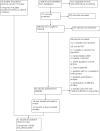
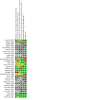
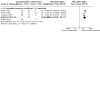

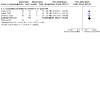

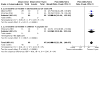
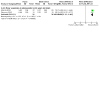
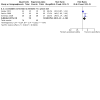
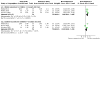
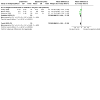
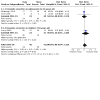
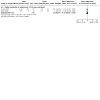


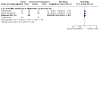

Update of
-
Orthodontic treatment for posterior crossbites.Cochrane Database Syst Rev. 2014 Aug 8;(8):CD000979. doi: 10.1002/14651858.CD000979.pub2. Cochrane Database Syst Rev. 2014. Update in: Cochrane Database Syst Rev. 2021 Dec 24;12:CD000979. doi: 10.1002/14651858.CD000979.pub3. PMID: 25104166 Updated.
References
References to studies included in this review
Alberta 2010 {published and unpublished data}
-
- Lagravere MO, Carey J, Heo G, Toogood RW, Major PW. Transverse, vertical, and anteroposterior changes from bone-anchored maxillary expansion vs traditional rapid maxillary expansion: a randomized clinical trial. American Journal of Orthodontics and Dentofacial Orthopedics 2010;137(3):304. - PubMed
-
- Lagravere MO, Ling CP, Woo J, Harzer W, Major PW, Carey JP. Transverse, vertical, and anterior-posterior changes between tooth-anchored versus Dresden bone-anchored rapid maxillary expansion 6 months post-expansion: a CBCT randomized controlled clinical trial. International Orthodontist 2020;18:308-16. - PubMed
-
- McLeod L, Hernández IA, Heo G, Lagravere MO. Condylar positional changes in rapid maxillary expansion assessed with cone-beam computer tomography. International Orthodontist 2016;14(3):342-56. [DOI: ] - PubMed
Araujo 2020 {published data only}
-
- Araujo MC, Bocato JR, Oltramari PV, Almeida MR, Conti AC, Fernandes TM. Tomographic evaluation of dentoskeletal effects of rapid maxillary expansion using Haas and Hyrax palatal expanders in children: a randomized clinical trial. Journal of Clinical & Experimental Dentistry 2020;12(10):e922-30. - PMC - PubMed
Asanza 1997 {published data only}
-
- Asanza S. Comparison of Hyrax and bonded expansion appliances. Angle Orthodontist 1997;67(1):15-22. - PubMed
Baysal 2016 {published data only}
Celenk‐Koca 2018 {published and unpublished data}
Cheung 2020 {published data only}
-
- Cheung GC, Dalci O, Mustac S, Papageorgiou SN, Hammond S, Darendeliler MA, et al. The upper airway volume effects produced by Hyrax, Hybrid-Hyrax, and Keles keyless expanders: a single-centre randomized controlled trial. European Journal of Orthodontics 2021;43(3):254-64. - PubMed
Dindaroglu 2016 {published data only}
Erhamza 2018 {published and unpublished data}
Garib 2005 {published data only}
-
- Garib DG, Henriques JF, Janson G, Freitas MR, Coelho RA. Rapid maxillary expansion - tooth tissue-borne versus tooth-borne expanders: a computed tomography evaluation of dentoskeletal effects. Angle Orthodontist 2005;75(4):548-57. - PubMed
Godoy 2011 {published and unpublished data}
-
- Godoy F, Godoy-Bezerra J, Rosenblatt A. Treatment of posterior crossbite comparing 2 appliances: a community-based trial. American Journal of Orthodontics and Dentofacial Orthopedics 2011;139:e45-52. - PubMed
Gopalakrishnan 2017 {published data only}
Halicioglu 2014 {published data only}
-
- Halıcıoğlu K, Yavuz I. Comparison of the effects of rapid maxillary expansion caused by treatment with either a memory screw or a Hyrax screw on the dentofacial structures--transversal effects. European Journal of Orthodontics 2014;36(2):140-9. [PMID: ] - PubMed
-
- Halicioğlu K, Yavuz I. A comparison of the sagittal and vertical dentofacial effects of maxillary expansion produced by a memory screw and a hyrax screw. Australian Orthodontics Journal 2016;31(1):31-40. [PMID: ] - PubMed
Kilic 2008 {published data only}
-
- Kilic N, Kiki A, Oktay H. A comparison of dentoalveolar inclination treated by two palatal expanders. European Journal of Orthodontics 2008;30(1):67-72. - PubMed
Lamparski 2003 {published data only}
-
- Lamparski DG Jr, Rinchuse DJ, Close JM, Sciote JJ. Comparison of skeletal and dental changes between 2-point and 4-point rapid palatal expanders. American Journal of Orthodontics and Dentofacial Orthopedics 2003;123(3):321-8. - PubMed
Lippold 2013 {published data only}
Martina 2012 {published data only}
-
- Martina R, Cioffi I, Farella M, Leone P, Manzo P, Matarese G, et al. Transverse changes determined by rapid and slow maxillary expansion. A low-dose CT-based randomised controlled trial. Orthodontics & Craniofacial Research 2012;15:159-68. - PubMed
Massaro 2020 {published data only}
-
- Massaro C, Garib D, Cevidanes L, Janson G, Yatabe M, Lauris JRP, et al. Maxillary dentoskeletal outcomes of the expander with differential opening and the fan-type expander: a randomized controlled trial. Clinical Oral Investigations 2021;25(9):5247-56. [DOI: 10.1007/s00784-021-03832-9] [PMID: ] - DOI - PMC - PubMed
-
- Massaro C, Janson G, Miranda F, Aliaga-Del Castillo A, Pugliese F, Lauris JR, et al. Dental arch changes comparison between expander with differential opening and fan-type expander: a randomized controlled trial. European Journal of Orthodontics 2020;43(3):265-73. - PubMed
McNally 2005 {published and unpublished data}
-
- McNally MR, Spary DJ, Rock WP. Randomized controlled trial comparing the quadhelix and the expansion arch for the correction of crossbite. Journal of Orthodontics 2005;32(1):29-35. - PubMed
Mossaz‐Joelson 1989 {published and unpublished data}
-
- Mossaz-Joelson K, Mossaz C. Slow maxillary expansion: a comparison between bonded and banded appliances. European Journal of Orthodontics 1989;11:67-76. - PubMed
Nam 2020 {published and unpublished data}
-
- Nam HJ, Gianoni-Capenakas S, Major PW, Heo G, Lagravere MO. Comparison of skeletal and dental changes obtained from a tooth-borne maxillary expansion appliance compared to the Damon system assessed through a digital volumetric imaging: a randomized clinical trial. Journal of Clinical Medicine 2020;9(10):1-14. [DOI: 10.3390/jcm9103167] - DOI - PMC - PubMed
Oliveira 2004 {published data only}
-
- Ghandehari B. A Comparison of the Skeletal Effects of Toothborne and Tissue-Borne Rapid Palatal Expanders [thesis]. Chicago: University of Illinois at Chicago, 2001.
-
- Oliveira NL, Da Silveira AC, Kusnoto B, Viana G. Three-dimensional assessment of morphologic changes of the maxilla: a comparison of 2 kinds of palatal expanders. American Journal of Orthodontics and Dentofacial Orthopedics 2004;126(3):354-62. - PubMed
Oshagh 2012 {published data only}
-
- Oshagh M, Momeni Danaei Sh, Hematiyan MR, Hajian Kh, Shokoohi Z. Comparison of dental arch changes and patients' discomforts between newly designed maxillary expansion screw and slow expansion procedures. Journal of Dentistry, Shiraz University of Medical Sciences 2012;13(3):110-9.
Ottaviano 2018 {published and unpublished data}
-
- Ottaviano G, Maculan P, Borghetto G, Favero V, Galletti B, Savietto E, et al. Nasal function before and after rapid maxillary expansion in children: a randomized, prospective, controlled study. International Journal of Pediatric Otorhinolaryngology 2018;115:133-8. [DOI: 10.1016/j.ijporl.2018.09.029] - DOI - PubMed
Petrén 2008 {published data only}
-
- Petrén S, Bjerklin K, Bondemark L. Stability of unilateral posterior crossbite correction in the mixed dentition: a randomized clinical trial with a 3-year follow-up. American Journal of Orthodontics and Dentofacial Orthopedics 2011;139:e73-81. [10.1016/j.ajodo.2010.06.018] - PubMed
-
- Petrén S, Bjerklin K, Marké LÅ, Bondemark L. Early correction of posterior crossbite--a cost-minimization analysis. European Journal of Orthodontics 2013;35(1):14-21. [DOI: ] - PubMed
-
- Petrén S, Bondemark L. Correction of unilateral posterior crossbite in the mixed dentition: a randomized controlled trial. American Journal of Orthodontics and Dentofacial Orthopedics 2008;133:790.e7-13. - PubMed
Ramoglu 2010 {published data only}
-
- Ramoglu SI, Sari Z. Maxillary expansion in the mixed dentition: rapid or semi-rapid? European Journal of Orthodontics 2010;32:11-8. - PubMed
Sollenius 2020 {published data only}
-
- Sollenius O, Golez A, Primozic J, Ovsenik M, Bomdemark L, Petrén S. Three-dimensional evaluation of forced unilateral posterior crossbite correction in the mixed dentition: a randomized controlled trial. European Journal of Orthodontics 2020;42(4):415-25. [DOI: ] - PubMed
Sweden 2017 {published and unpublished data}
Thilander 1984 {published data only}
-
- Thilander B, Wahlund S, Lennartsson B. The effect of early interceptive treatment in children with posterior cross-bite. European Journal of Orthodontics 1984;6:25-34. - PubMed
Toklu 2015 {published data only}
-
- Toklu MG, Germec-Cakan D, Tozlu M. Periodontal, dentoalveolar, and skeletal effects of tooth-borne and tooth-bone-borne expansion appliances. American Journal of Orthodontics and Dentofacial Orthopedics 2015;148:97-109. [DOI: ] - PubMed
Ugolini 2015 {published data only}
-
- Cerruto C, Ugolini A, Di Vece L, Doldo T, Caprioglio A, Silvestrini-Biavati A. Three-dimensional evaluation of forced unilateral posterior crossbite correction in the mixed dentition: a randomized controlled trial. Journal of Orofacial Orthopedics 2017;78:385-93. [DOI: 10.1007/s00056-017-0092-2] - DOI - PubMed
-
- Ugolini A, Cerruto C, Di Vece L, Ghislanzoni LH, Sforza C, Doldo T, et al. Dental arch response to Haas-type rapid maxillary expansion anchored to deciduous vs permanent molars: a multicentric randomized controlled trial. Angle Orthodontist 2015;85:570-6. [DOI: 10.2319/041114-269.1] - DOI - PMC - PubMed
References to studies excluded from this review
Akim 2021 {published data only}
-
- Akim M, Ozturk O. Evaluation and comparison of root resorption resulting from traditional and bone-borne rapid maxillary expansion appliances using cone-beam computed tomography. Meandros Medical and Dental Journal 2021;22(1):77-84.
Alghamdi 2017 {published data only}
Altieri 2020 {published data only}
-
- Altieri F, Cassetta M. The impact of tooth-borne vs computer-guided bone-borne rapid maxillary expansion on pain and oral health-related quality of life: a parallel cohort study. American Journal of Orthodontics and Dentofacial Orthopedics 2020;158(5):e83-e90. - PubMed
Altindis 2016 {published data only}
Alves 2020 {published data only}
-
- Alves AC, Janson G, Mcnamara JA Jr, Lauris JR, Garib DG. Maxillary expander with differential opening vs Hyrax expander: a randomized clinical trial. American Journal of Orthodontics and Dentofacial Orthopedics 2020;157(1):7-18. - PubMed
Annarumma 2021 {published data only}
-
- Annarumma F, Posadino M, De Mari A, Drago S, Aghazada H, Gravina GM, et al. Skeletal and dental changes after maxillary expansion with a bone-borne appliance in young and late adolescent patients. American Journal of Orthodontics and Dentofacial Orthopedics 2021;159(4):e363-75. - PubMed
Baldini 2018 {published data only}
-
- Baldini A, Nota A, Santariello C, Assi V, Ballanti F, Cozza P. A comparative assessment of changes in dental arches associated with different activation protocols of rapid maxillary expansion. European Journal of Paediatric Dentistry 2018;19(1):35-9. - PubMed
-
- Baldini A, Nota A, Santariello C, Caruso S, Assi V, Ballanti F, et al. Sagittal dentoskeletal modifications associated with different activation protocols of rapid maxillary expansion. European Journal of Paediatric Dentistry 2018;19(2):151-5. - PubMed
Baratieri 2014 {published data only}
Barone 2020 {published data only}
-
- Barone TR, Cahali MB, Vasconcelos C, Barone JR. A comparison of tooth-borne and bone-anchored expansion devices in SARME. Oral and Maxillofacial Surgery 2020;24(2):181-7. - PubMed
Biondi 2017 {published data only}
-
- Biondi E, Bandini A, Lombardo L, Orlandi S, Siciliani G, Manfredi C. Phonetic analysis during treatment with rapid maxillary expander. Orthodontics & Craniofacial Research 2017;20(1):21-9. - PubMed
Calil 2020 {published data only}
-
- Calil RC, Marin Ramirez CM, Otazu A, Torres DM, Gurgel JA, Oliveira RC, et al. Maxillary dental and skeletal effects after treatment with self-ligating appliance and miniscrew-assisted rapid maxillary expansion. American Journal of Orthodontics and Dentofacial Orthopedics 2020;159(2):e93-101. - PubMed
Canan 2017 {published data only}
-
- Canan S, Senisik NE. Comparison of the treatment effects of different rapid maxillary expansion devices on the maxilla and the mandible. Part 1: evaluation of dentoalveolar changes. American Journal of Orthodontics and Dentofacial Orthopedics 2017;151(6):1125-38. - PubMed
Caprioglio 2020 {published data only}
-
- Caprioglio A, Castiglioni F, Sambataro S, Giuntini V, Comaglio I, Lorvetti F, et al. Changes in canine inclination after rapid and slow maxillary expansion compared to untreated controls. Orthodontics & Craniofacial Research 2020;23(3):351-6. - PubMed
Cossellu 2019 {published data only}
-
- Cossellu G, Lanteri V, Lione R, Ugolini A, Gaffuri F, Cozza P, et al. Efficacy of ketoprofen lysine salt and paracetamol/acetaminophen to reduce pain during rapid maxillary expansion: a randomized controlled clinical trial. International Journal of Paediatric Dentistry 2019;29(1):58-65. [DOI: 10.1111/ipd.12428] - DOI - PubMed
Cunha 2019 {published data only}
-
- Cunha TCA. Treatment of childhood obstructive sleep apnea - adenotonsilectomy x rapid maxillary expansion - prospective, randomized, crossover study - partial results. Sleep Science 2019;12(1):16.
Davami 2020 {published data only}
-
- Davami K, Talma E, Harzer W, Lagravere MO. Long term skeletal and dental changes between tooth-anchored versus Dresden bone-anchored rapid maxillary expansion using CBCT images in adolescents: randomized clinical trial. International Orthodontics 2020;18:317-29. - PubMed
Digregorio 2019 {published data only}
-
- Digregorio MV, Fastuca R, Zecca PA, Caprioglio A, Lagravère MO. Buccal bone plate thickness after rapid maxillary expansion in mixed and permanent dentitions. American Journal of Orthodontics and Dentofacial Orthopedics 2019;155(2):198-206. - PubMed
Erdur 2020 {published data only}
Farret 2015 {published data only}
Fastuca 2017 {published data only}
Ferreira 2016 {published data only}
-
- Ferreira FN, Gondim JO, Neto JJ, Dos Santos PC, Freitas Pontes KM, Kurita LM, et al. Effects of low-level laser therapy on bone regeneration of the midpalatal suture after rapid maxillary expansion. Lasers in Medical Science 2016;31(5):907-13. - PubMed
Garcia 2016 {published data only}
-
- Garcia VJ, Arnabat J, Comesana R, Kasem K, Ustrell JM, Pasetto S, et al. Effect of low-level laser therapy after rapid maxillary expansion: a clinical investigation. Lasers in Medical Science 2016;31(6):1185-94. - PubMed
Garib 2021 {published data only}
Gianoni‐Capenakas 2021 {published data only}
-
- Gianoni-Capenakas S, Flores-Mir C, Vich ML, Pacheco-Pereira C. Oropharyngeal 3-dimensional changes after maxillary expansion with 2 different orthodontic approaches. American Journal of Orthodontics and Dentofacial Orthopedics 2021;159(3):352-9. - PubMed
Jacob 2019 {published data only}
Jia 2021 {published data only}
Kabalan 2015 {published data only}
-
- Kabalan O, Gordon J, Heo G, Lagravère MO. Nasal airway changes in bone-borne and tooth-borne rapid maxillary expansion treatments International orthodontics. College Europeen d'Orthodontie 2015;13(1):1-15. - PubMed
Kayalar 2019 {published data only}
-
- Kayalar E, Schauseil M, Hellak A, Emekli U, Fıratlı S, Korbmacher-Steiner H. Nasal soft- and hard-tissue changes following tooth-borne and hybrid surgically assisted rapid maxillary expansion: a randomized clinical cone-beam computed tomography study. Journal of Cranio-maxillo-facial Surgery 2019;47(8):1190-7. - PubMed
Kilic 2016 {published data only}
Lee 2021 {published data only}
-
- Lee DW, Park JH, Moon W, Seo HY, Chae JM. Effects of bicortical anchorage on pterygopalatine suture opening with microimplant-assisted maxillary skeletal expansion. American Journal of Orthodontics and Dentofacial Orthopedics 2021;159(4):502-11. - PubMed
Lione 2018 {published data only}
Malkoc 2021 {published data only}
Matos 2020 {published data only}
-
- Matos DS, Palma-Dibb RG, Oliveira Santos C, da Conceicao Pereira Saraiva M, Marques FV, Matsumoto MA, et al. Evaluation of photobiomodulation therapy to accelerate bone formation in the mid palatal suture after rapid palatal expansion: a randomized clinical trial. Lasers in Medical Science 2021;36(5):1039-46. [DOI: 10.1007/s10103-020-03141-9] [PMID: ] - DOI - PubMed
Melgaco 2014 {published data only}
Michelotti 2019 {published data only}
-
- Michelotti A, Rongo R, Valentino R, D'Antò V, Bucci R, Danzi G, et al. Evaluation of masticatory muscle activity in patients with unilateral posterior crossbite before and after rapid maxillary expansion. European Journal of Orthodontics 2019;41(1):46-53. - PubMed
Mohan 2016 {published data only}
-
- Mohan CN, Araujo EA, Oliver DR, Kim KB. Long-term stability of rapid palatal expansion in the mixed dentition vs the permanent dentition. American Journal of Orthodontics and Dentofacial Orthopedics 2016;149(6):856-62. - PubMed
Nagrik 2020 {published data only}
-
- Nagrik AP, Bhad WA, Chavan SJ, Doshi UH. A randomized clinical trial to assess the sagittal effects of Transforce transverse appliance (TTA) and NiTi palatal expander (NPE) on skeletal class II malocclusion in growing patients during retention phase - a cephalometric study using a historical control group. International Orthodontics 2020;18(4):722-31. - PubMed
Nieri 2020 {published data only}
-
- Nieri M, Paoloni V, Lione R, Barone V, Marino Merlo M, Giuntini V, et al. Comparison between two screws for maxillary expansion: a multicenter randomized controlled trial on patient's reported outcome measures. European Journal of Orthodontics 2021;43(3):293-300. [DOI: 10.1093/ejo/cjaa063] [PMID: ] - DOI - PubMed
Petrén 2011 {published data only}
-
- Petrén S, Bjerklin K, Bondemark L. Stability of unilateral posterior crossbite correction in the mixed dentition: a randomized clinical trial with a 3-year follow-up. American Journal of Orthodontics and Dentofacial Orthopedics 2011;139(1):e73-81. - PubMed
Ribeiro 2020 {published data only}
-
- Ribeiro GL, Jacob HB, Brunetto M, Pereira JS, Tanaka OM, Buschang PH. A preliminary 3-D comparison of rapid and slow maxillary expansion in children: a randomized clinical trial. International Journal of Paediatric Dentistry 2020;30(3):349-59. - PubMed
Rinaldi 2018 {published data only}
-
- Rinaldi MR, Azeredo F, Lima EM, Rizzatto SM, Sameshima G, Menezes LM. Cone-beam computed tomography evaluation of bone plate and root length after maxillary expansion using tooth-borne and tooth-tissue-borne banded expanders. American Journal of Orthodontics and Dentofacial Orthopedics 2018;154(4):504-16. - PubMed
Ring 2020 {published data only}
Taner 2018 {published data only}
Ugolini 2020 {published data only}
-
- Ugolini A, Cossellu G, Farronato M, Silvestrini-Biavati A, Lanteri V. A multicenter, prospective, randomized trial of pain and discomfort during maxillary expansion: leaf expander versus Hyrax expander. International Journal of Paediatric Dentistry 2020;30(4):421-8. - PubMed
Weissheimer 2011 {published data only}
-
- Weissheimer A, Menezes LM, Mezomo M, Marchiori D, Lima EM, Rizzatto SM. Immediate effects of rapid maxillary expansion with Haas-type and Hyrax-type expanders: a randomized clinical trial. American Journal of Orthodontics and Dentofacial Orthopedics 2011;140(3):366-76. - PubMed
Yagci 2016 {published data only}
-
- Yagci A, Korkmaz YN, Yagci F, Atilla AO, Buyuk SK. Effect of 3 cements on white spot lesion formation after full-coverage rapid maxillary expander: a comparative in-vivo study. American Journal of Orthodontics and Dentofacial Orthopedics 2016;150(6):1005-13. - PubMed
Additional references
Andrade 2009
-
- Andrade Ada S, Gameiro GH, Derossi M, Gavião MB. Posterior crossbite and functional changes. A systematic review. Angle Orthodontist 2009;79(2):380-6. [10.2319/030708-137.1] - PubMed
Boronat‐Catalá 2017
-
- Boronat-Catalá M, Montiel-Company JM, Bellot-Arcís C, Almerich-Silla JM, Catalá-Pizarro M. Association between duration of breastfeeding and malocclusions in primary and mixed dentition: a systematic review and meta-analysis. Science Reports 2017;11(1):5048. [DOI: 10.1038/s41598-017-05393-y] - DOI - PMC - PubMed
Borrie 2015
Bresolin 1983
-
- Bresolin D, Shapiro PA, Shapiro GG, Chapko MK, Dassel S. Mouth breathing in allergic children: its relationship to dentofacial development. American Journal of Orthodontics 1983;83:334-40. - PubMed
Caroccia 2021
Cheng 1988
-
- Cheng M-C, Enlow DH, Papsidero M, Broadbent BH, Oyen O, Sabat M. Developmental effects of impaired breathing in the face of the growing child. Angle Orthodontist 1988;58:309-20. - PubMed
D'Onofrio 2019
Deeks 2021
-
- Deeks JJ, Higgins JP, Altman DG editor(s). Chapter 10: Analysing data and undertaking meta-analyses. In: Higgins JP, Thomas J, Chandler J, Cumpston M, Li T, Page MJ, Welch VA editor(s). Cochrane Handbook for Systematic Reviews of Interventions Version 6.2 (updated February 2021). Cochrane, 2021. Available from www.training.cochrane.org/handbook.
Egermark 1990
-
- Egermark-Eriksson I, Carlsson GE, Magnusson T, Thilander B. A longitudinal study on malocclusion in relation to signs and symptoms of cranio-mandibular disorders in children and adolescents. European Journal of Orthodontics 1990;12:399-407. - PubMed
Egger 1997
Ellabban 2018
-
- Ellabban MT, Abdul-Aziz AI, Fayed MM, AboulFotouh MH, Elkattan ES, Dahaba MM. Positional and dimensional temporomandibular joint changes after correction of posterior crossbite in growing patients: a systematic review. Angle Orthodontist 2018;88(5):638-48. [DOI: 10.2319/110217-749.1] - DOI - PMC - PubMed
Gesch 2004
-
- Gesch D, Bernhardt O, Kirbschus A. Association of malocclusion and functional occlusion with temporomandibular disorders (TMD) in adults: a systematic review of population-based studies. Quintessence International 2004;35(3):211-21. - PubMed
GRADE 2004
GRADEpro GDT [Computer program]
-
- GRADEpro GDT. Version accessed 1 August 2021. Hamilton (ON): McMaster University (developed by Evidence Prime). Available at gradepro.org.
Heikinheimo 1987
-
- Heikinheimo K, Salmi K, Myllarniemi S. Long term evaluation of orthodontic diagnosis made at the ages of 7 and 10 years. European Journal of Orthodontics 1987;9:151-9. - PubMed
Higgins 2003
Higgins 2017
-
- Higgins JP, Altman DG, Sterne JA editor(s). Chapter 8: Assessing risk of bias in included studies. In: Higgins JP, Churchill R, Chandler J, Cumpston MS editor(s), Cochrane Handbook for Systematic Reviews of Interventions Version 5.2.0 (updated June 2017), Cochrane, 2017. Available from www.training.cochrane.org/handbook.
Iodice 2013
-
- Iodice G, Danzi G, Cimino R, Paduano S, Michelotti A. Association between posterior crossbite, masticatory muscle pain, and disc displacement: a systematic review. European Journal of Orthodontics 2013;35(6):737-44. - PubMed
Iodice 2016
Kennedy 2005
-
- Kennedy DB, Osepchook M. Unilateral posterior crossbite with mandibular shift: a review. Journal of the Canadian Dental Association 2005;71(8):569-73. - PubMed
Kurol 1992
-
- Kurol J, Berglund L. Longitudinal and cost-benefit analysis of the effect of early treatment of posterior cross-bites in the primary dentition. European Journal of Orthodontics 1992;14:173-9. - PubMed
Lefebvre 2021
-
- Lefebvre C, Glanville J, Briscoe S, Littlewood A, Marshall C, Metzendorf M-I, et al. Technical Supplement to Chapter 4: Searching for and selecting studies. In: Higgins JP, Thomas J, Chandler J, Cumpston M, Li T, Page MJ, Welch VA, editor(s). Cochrane Handbook for Systematic Reviews of Interventions Version 6.1 (updated September 2021). Cochrane, 2021. Available from www.training.cochrane.org/handbook.
Leighton 1966
-
- Leighton BC. The early development of cross-bites. Dental Practitioner 1966;17:145-52. - PubMed
Lindner 1989
-
- Lindner A. Longitudinal study on the effect of early interceptive treatment in 4-year-old children with unilateral cross-bite. Scandinavian Journal of Dental Research 1989;97(5):432-8. - PubMed
Lombardo 2020
Malandris 2004
-
- Malandris M, Mahoney EK. Aetiology, diagnosis and treatment of posterior cross-bites in the primary dentition. International Journal of Paediatric Dentistry 2004;14(3):155-66. - PubMed
McNamara 1997
-
- McNamara JA Jr, Turp JC. Orthodontic treatment and temporomandibular disorders: is there a relationship? Journal of Orofacial Orthopedics 1997;58:74-89. - PubMed
Modeer 1982
-
- Modeer T, Odenrick L, Lindner A. Sucking habits and their relationship to posterior crossbites in 4-year-old children. Scandinavian Journal of Dental Research 1982;90:323-8. - PubMed
Ninou 1994
-
- Ninou S, Stephens C. The early treatment of posterior crossbites: a review of continuing controversies. Dental Update 1994;21:420-6. - PubMed
O'Bryn 1995
-
- O'Bryn BL, Sadowsky C, Schneider B, BeGole EA. An evaluation of mandibular asymmetry in adults with unilateral posterior crossbite. American Journal of Orthodontics and Dentofacial Orthopedics 1995;107:394-400. - PubMed
Ogaard 1994
-
- Ogaard B, Larsson E, Lindsten R. The effects of sucking habits, cohort, sex, intercanine arch widths, and breast or bottle feeding on posterior crossbite in Norwegian and Swedish 3-year-old children. American Journal of Orthodontics and Dentofacial Orthopedics 1994;106:161-6. - PubMed
Pullinger 1993
-
- Pullinger AG, Seligman DA, Gornbein JA. A multiple logistic regression analysis of the risk and relative odds of temperomandibular disorders as a function of common occlusal factors. Journal of Dental Research 1993;72:968-79. - PubMed
Schmid 2018
Schulz 1995
-
- Schulz KF, Chalmers I, Hayes RJ, Altman DG. Empirical evidence of bias. Dimensions of methodological quality associated with estimates of treatment effects in controlled trials. JAMA 1995;273(5):408-12. - PubMed
Schulz 2010
Subtelny 1980
-
- Subtelny JD. Oral respiration: facial maldevelopment and corrective dentofacial orthopedics. Angle Orthodontist 1980;50:147-64. - PubMed
Talapaneni 2012
Thilander 2002
-
- Thilander B, Rubio G, Pena L, Mayorga C. Prevalence of temporomandibular dysfunction and its association with malocclusion in children and adolescents: an epidemiologic study related to specified stages of dental development. Angle Orthodontist 2002;72(2):146-54. - PubMed
Thilander 2012
-
- Thilander B, Bjerklin K. Posterior crossbite and temporomandibular disorders (TMDs): need for orthodontic treatment? European Journal of Orthodontics 2012;34(6):667-73. - PubMed
Tsanidis 2016
-
- Tsanidis N, Antonarakis GS, Kiliaridis S. Functional changes after early treatment of unilateral posterior cross-bite associated with mandibular shift: a systematic review. Journal of Oral Rehabilitation 2016;43(1):59-68. - PubMed
Tsichlaki 2020
Williamson 2012
Zuccati 2013
-
- Zuccati G, Casci S, Doldo T, Clauser C. Expansion of maxillary arches with crossbite: a systematic review of RCTs in the last 12 years. European Journal of Orthodontics 2013;35(1):29-37. - PubMed
References to other published versions of this review
Agostino 2014
Publication types
MeSH terms
LinkOut - more resources
Full Text Sources
Miscellaneous

